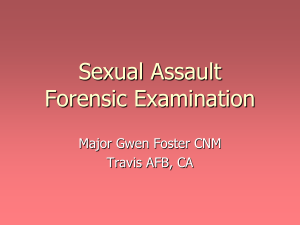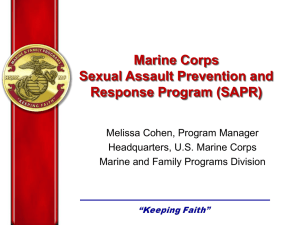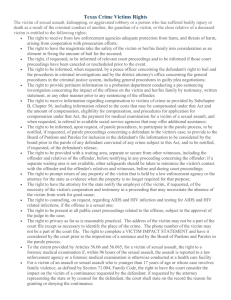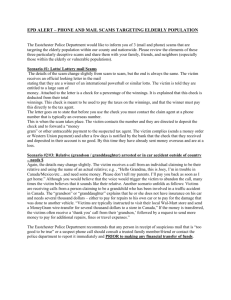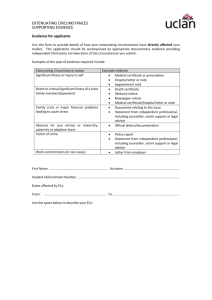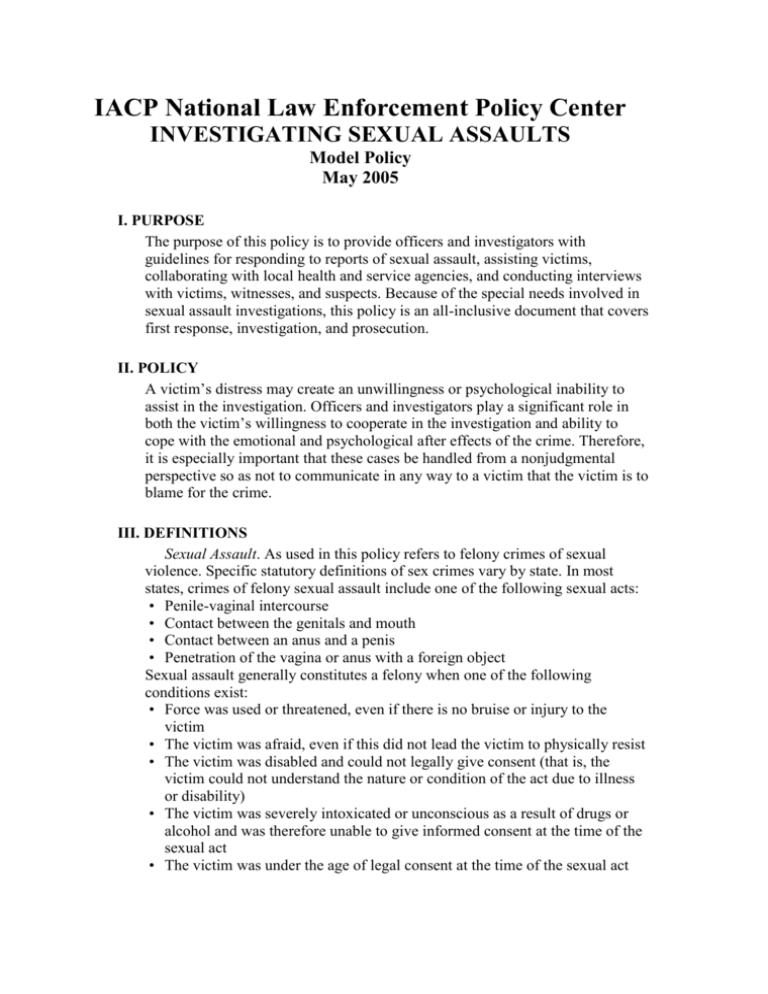
IACP National Law Enforcement Policy Center
INVESTIGATING SEXUAL ASSAULTS
Model Policy
May 2005
I. PURPOSE
The purpose of this policy is to provide officers and investigators with
guidelines for responding to reports of sexual assault, assisting victims,
collaborating with local health and service agencies, and conducting interviews
with victims, witnesses, and suspects. Because of the special needs involved in
sexual assault investigations, this policy is an all-inclusive document that covers
first response, investigation, and prosecution.
II. POLICY
A victim’s distress may create an unwillingness or psychological inability to
assist in the investigation. Officers and investigators play a significant role in
both the victim’s willingness to cooperate in the investigation and ability to
cope with the emotional and psychological after effects of the crime. Therefore,
it is especially important that these cases be handled from a nonjudgmental
perspective so as not to communicate in any way to a victim that the victim is to
blame for the crime.
III. DEFINITIONS
Sexual Assault. As used in this policy refers to felony crimes of sexual
violence. Specific statutory definitions of sex crimes vary by state. In most
states, crimes of felony sexual assault include one of the following sexual acts:
• Penile-vaginal intercourse
• Contact between the genitals and mouth
• Contact between an anus and a penis
• Penetration of the vagina or anus with a foreign object
Sexual assault generally constitutes a felony when one of the following
conditions exist:
• Force was used or threatened, even if there is no bruise or injury to the
victim
• The victim was afraid, even if this did not lead the victim to physically resist
• The victim was disabled and could not legally give consent (that is, the
victim could not understand the nature or condition of the act due to illness
or disability)
• The victim was severely intoxicated or unconscious as a result of drugs or
alcohol and was therefore unable to give informed consent at the time of the
sexual act
• The victim was under the age of legal consent at the time of the sexual act
Victim Advocate. This generic term may apply to a wide range of service
providers, rape crisis counselors, social workers, victim witness providers
within a prosecutor's office, and law enforcement officers, including
departmental victim assistants. Depending on the primary functions of these
different advocates, the levels of confidentiality and privilege they have will
vary and should, therefore, always be understood by each member of the sexual
assault response team and communicated to the victim.
IV. PROCEDURES
A. Dispatcher or Call-Taker Response
1. Due to the trauma of a sexual assault, a victim reaching out for assistance
may be in crisis. The victim’s behaviors may actually be symptomatic of
this condition and can range from hysteria, crying and rage to laughter,
calmness, and unresponsiveness. There is no one typical reaction, so it is
important to refrain from judging or disregarding any victim.
2. When a caller reports a sexual assault, communications personnel shall
follow standard emergency response to include evaluating and properly
prioritizing the call, securing medical assistance, inquiring about a
suspect's current location, and obtaining detailed information to identify
the suspect. Information about the relationship with the victim, weapon
use, and history of violence shall also be obtained.
3. To ensure critical evidence is not lost, communications personnel shall:
a. Ask whether the victim has bathed, douched, urinated, or made other
physical changes and advise against doing so
b. Ask the victim to use a clean jar to collect the urine should the victim
have to urinate
c. Let the victim know that other evidence may still be identified and
recovered so the crime should still be reported if the victim has bathed
or made other physical changes
d. Preserve the communications tape and printout for the investigation
e. Explain to the caller that these questions will not delay an officer’s
response to the caller’s location
B. Initial Officer Response
1. Emergency Response
As part of the emergency response, officers shall:
a. Make contact with the victim as soon as possible to address safety
concerns and summon emergency medical assistance if needed
b. Evaluate the scene for people, vehicles, or objects involved as well as
possible threats
c. Relay all vital information to responding officers and supervisors,
including any possible language barriers
d. Secure the crime scene to ensure that evidence is not lost, changed, or
contaminated
e. Request assistance from detectives, field evidence technicians, crime
laboratory personnel, and the prosecuting attorney when appropriate
2
f. Begin a search for the suspect when appropriate
2. Assisting the Victim
As part of the emergency response, officers shall:
a. Show understanding, patience, and respect for the victim’s dignity and
attempt to establish trust and rapport.
b. Inform the victim that an officer of the same sex will be provided if
desired and available.
c. Contact a victim advocate as soon as possible to provide assistance
throughout the reporting and investigative process.
d. Supply victims of sexual assault with the phone number for the Rape,
Abuse, and Incest National Network (RAINN) Hotline, 1-800-656HOPE. Operators at this hotline connect the caller with the rape crisis
center closest to the victim’s location.
e. Request a response from investigations, and clearly explain his or her
role and limit the preliminary interview so that the victim is not then
asked the same questions by a detective.
f. Be aware that a victim of sexual assault may bond with the first
responding officer. It is important to explain the role of the different
members of the sexual assault response team and help with transitions
through introductions.
g. Record observations of the crime scene, including the demeanor of the
suspect and victim and document any injuries or disheveled clothing.
3. Evidence Collection Issues
a. Officers shall request assistance or direction from crime scene
technicians and forensic scientists.
b. Responding officers shall protect the integrity of the evidence and
guard the chain of custody by properly marking, packaging, and
labeling all evidence collected, including:
(1) Clothing worn at the time of the assault and immediately afterward,
especially the clothing worn closest to the genitals (such as
undergarments, pants, and shorts)
(2) Photographs and videotape of the victim’s injuries (if any), the
suspect’s injuries (if any), and the crime scene prior to processing
• When photographing a victim, be sensitive to the location of the
injuries on the victim’s body
• Summon an officer of the same sex as the victim
• Photograph victims using drapes and other techniques that help
to maintain the victim’s dignity
• Instruct medical personnel to take photographs of the genitalia
when needed
(3) Diagram of the crime scene(s)
c. When an investigating officer suspects that a sexual assault may have
been facilitated with drugs or alcohol, he or she should determine the
time of the incident as soon as possible in order to make decisions
regarding the collection of urine and blood samples.
3
d. Officers shall introduce the need for a medical examination to the
victim explaining the importance to investigative and apprehension
efforts as well as for the victim’s well being. Officers shall not coerce
victims to go to the hospital or to provide samples for drug screening.
e. DNA evidence plays a crucial role in the sexual assault investigation.
In addition to the victim’s and suspect’s bodies and clothing, there are
many other potential sources such as condoms, sheets, blankets,
pillows, and bottles that may contain biological evidence such as
blood, sweat, tissue, saliva, hair, and urine. To properly collect DNA
evidence, officers shall:
(1) Use sterile gloves and change as needed
(2) Use sterile swabs, papers, solutions, and tools
(3) Package evidence in individual envelopes
(4) Avoid touching the area where potential DNA evidence may exist
(5) Avoid talking, sneezing, and coughing over evidence
(6) Air dry evidence before packaging
(7) Put evidence into new paper bags or envelopes, not plastic
f. The sexual assault evidence kit shall be accepted from the medical
staff after it has been properly sealed and labeled.
(1) The kit will contain whole blood that requires that the kit be placed
and logged into an evidence refrigerator as soon as possible. The kit
may also contain a urine sample for toxicology testing. If it does, the
urine sample shall also be refrigerated.
(2) Investigating officers or supervisors shall have access to the
evidence refrigerator after regular business hours, on weekends, and
on holidays.
(3) The kit shall not be allowed to freeze or be exposed to heat such as
being near a car’s interior heater.
4. Stranger vs. Nonstranger Assaults
Responding officers shall be familiar with common defenses to the
charges of sexual assault.
a. Nonstranger Assault
The majority of nonstranger sexual assaults result in a consent
defense. Thus, evidence of particular importance includes:
(1) Evidence of physical or verbal resistance on the part of the victim
(2) Evidence of genital or nongenital injury
(3) Detailed account of the victim’s thoughts and feelings during the
assault
(4) Information regarding the suspect’s size and strength in
comparison to the victim’s
(5) Information regarding the environment in which the assault took
place (such as isolation, soundproofing)
(6) Information regarding the victim’s behavior after the assault,
including posttraumatic stress
b. Stranger Assault
4
Evidence in stranger sexual assaults often center on a question of
identification pending the processing of DNA evidence. Therefore,
investigative strategies must remain flexible. An identity defense will
typically include latent fingerprints, lineups, DNA, and trace evidence.
5. Identify and Locate Witnesses and Suspects
Based on the victim’s emotional and physical state, questions of the
victim concerning the assault and description and location of the suspect
shall be limited. Responding officers must identify and interview any
potential witnesses, bearing in mind that there may be multiple crime
scenes. It is especially important that the first person the victim told about
the sexual assault be identified and interviewed.
6. Documentation
Any officer who interviews a witness or a suspect, identifies evidence, or
processes a crime scene shall write his or her own report detailing the
actions he or she took. These supplemental reports shall be compiled by
the first responding officer for the follow-up investigation regardless of
whether an arrest is made.
C. Preliminary Victim Interview
Sexual assault investigations typically include both a preliminary and
subsequent in-depth interview with the victim. The preliminary interview is
intended to establish whether a crime has occurred. In the initial response,
the officer shall first establish the elements of the crime(s) and identify any
and all witnesses, suspect(s), evidence, and crime scene(s). The officer must
understand and the report indicate that the preliminary interview is not
intended to be a comprehensive or final interview. Additional interviews will
be needed as the investigation develops.
1. Involve a Victim Advocate
Every effort shall be made by the investigating officer to contact a victim
advocate as soon as possible. If the victim declines assistance from an
advocate, the investigator shall provide the victim with written referrals
for community resources specifically designed to help victims of sexual
assault.
2. Victim Interview Protocol
a. Based on the length of time between the assault and report of the
crime and the individual’s personal history, the victim may be in crisis
and experiencing posttraumatic stress disorder or rape trauma
syndrome and exhibiting a range of behaviors that will likely change
over time.
b. The victim’s response to the trauma of a sexual assault shall not be
used in any way to measure credibility. When drugs or alcohol are
involved, the victim may have limited recollection or be unable to give
a complete account of the crime. Not knowing the details of what
happened may exacerbate the trauma experienced by the victim.
c. Interviews shall be conducted promptly if the victim is coherent and
consensual.
5
d. Proceeding with or conducting a thorough investigation shall not be
contingent upon laboratory findings.
(1) Investigators shall:
• Remain patient and maintain an open mind while listening to the
victim’s account
• Remember that victims may struggle with gaps in memory
• Avoid leading questions while conducting the interview
• Use simple terminology appropriate to the victim’s age,
sophistication, and intelligence
• Avoid using jargon or police, medical, or legal terms
(2) Prior to initiating the interview, the officer shall:
• Interview any witness who might have seen or spoken with the
victim before, during, or after the assault
• Accommodate the victim’s request for a rape crisis advocate or
support person whenever possible
• Take responsibility for excluding a support person when
appropriate and offer the victim and support person an
explanation
• Secure a private location for the interview that is free from
distractions
• Express sympathy to the victim and an interest in the victim’s
well-being
• Inform the victim of the need and importance of full disclosure
of any and all recent drug use
(3) During the interview, the officer shall:
• Obtain contact information for the victim, including temporary
accommodations
• Explain the nature of the preliminary interview and the need for
follow-up contacts
• Ask victims to explain what they remember and how they felt
• Revisit the possibility of a support person for victims who
initially declined the offer
• Explain that other professionals such as forensic examiners,
detectives, evidence technicians, and prosecutors may have
additional questions
(4) At the conclusion of the initial interview, the officer shall:
• Give the victim the investigator’s contact information
• Encourage the victim to contact the investigator with any
additional information or evidence
• Remind the victim that visible evidence of injury may appear
later, and to contact the investigators for additional photographs
or other documentation
• Ensure that requests for victim protection orders are made where
indicated
• Provide written referrals for victim service organizations
• Provide transportation when reasonably possible
6
• Inform the victim about next steps in the investigation
3. Protecting Victim Rights
a. Throughout the investigation of the case, officers shall protect the
confidentiality of the victim’s information to the maximum extent
possible by law and policy.
b. In addition, victims should be provided information on:
(1) The rights of a crime victim
(2) How to contact police if harassed or intimidated by the suspect(s)
(3) How to obtain written permission from the victim prior to releasing
information
(4) The definitions of information that is part of the public record and
confidential
(5) The possibility of media coverage and information the media has
access to regarding sexual assault crimes
4. Arrest and Prosecution Decisions
In the immediate aftermath of a sexual assault, a victim shall not be
expected or encouraged to make decisions regarding the investigation or
charges related to the offense. Officers shall not introduce any forms for a
victim to sign to decline an investigation.
5. Delayed Reports
Delayed victim reporting is common in sexual assault cases due to the
trauma and fear experienced by victims and should not deter a thorough
investigation. Officers shall inquire about and document the reasons for a
delayed report, while avoiding questions that could be perceived as
judgmental or accusatory.
D. Forensic Examinations for Victims of Sexual Assault
Victim-centered care is paramount to the success of the forensic examination
of victims of sexual assault. A timely, professional forensic examination
increases the likelihood that injuries will be documented and evidence
collected to aid in the investigation and prosecution of sex offenders.
Evidence may normally be collected up to 92 hours after the assault, but
evidence can be gathered and injuries documented beyond that time,
especially if the victim is injured, bleeding, or experiencing pain.
1. Investigating Officer Actions
a. Ask the victim whether there is anyone who should be called or
notified, and facilitate this contact
b. Address any special needs of the victim, such as communication or
mobility, and notify the victim advocate of the special need
c. Explain the purpose of the forensic examination and its importance to
the investigation and provide the victim with information on the
procedure
d. Inquire whether the victim will consent to a forensic examination
e. Inform the victim of the right to decline any or all parts of the
examination
7
f. Explain to the victim the potential consequences if any part of the
examination is refused
g. Notify a victim advocate to offer the victim support when a forensic
examination is to be conducted
h. Transport the victim to the designated medical facility if a forensic
examination is warranted and the victim consents
i. Advise the victim that the forensic examiner will collect any clothing
that was worn during or immediately after the sexual assault
j. Assist in arranging for clothing the victim may need after the
examination
k. Seek permission from the victim to collect a urine sample for drug
screening
l. Obtain a signed release from the victim for access to medical records
m. Encourage a victim who is unwilling to undergo a forensic exam to
get medical attention including testing for pregnancy and sexually
transmitted diseases
2. Coordination with Forensic Examiner
Responding officers shall coordinate with other professionals such as
forensic examiners and criminalists to determine whether a forensic
examination is indicated.
a. When a forensic examination is indicated, the investigating officer
shall brief the examining nurse or physician about the details of the
sexual assault, as they are known at that time.
b. Officers should not normally be present in the examining room as the
forensic examiner will testify about collection of evidence and the
chain of custody.
c. The nurse or physician shall brief the investigating officer at the
conclusion of the examination.
d. The police report shall contain a copy of the forensic exam, if
available, and a summary of the findings that note significant
information or injury. After the examination, all the evidence shall be
transferred to the department for storage.
3. Presence of a Victim Advocate
When it is determined that a forensic examination will be conducted, a
victim advocate or a support person of the victim’s choosing shall be
allowed to be present in the room and during the interview, unless it
would be harmful to the investigation. The officer shall take responsibility
for excluding a support person, when appropriate, and providing an
explanation to the victim and the support person.
4. Drug-Facilitated Sexual Assault Considerations
a. If a drug-facilitated sexual assault is suspected, it is critical to obtain a
urine sample from the victim as soon as possible. If it has been less
than 24 hours since the time of the assault, also obtain a blood sample
in a grey-top tube.
b. Protocols for responding to illegal substance abuse by victims
(including underage drinking) shall be followed and never used to
8
discredit or discourage the victim from reporting the assault. The
department priority is to conduct a thorough investigation of a sexual
assault rather than prosecute victims for misdemeanor violations.
c. Because of the delay in reporting most sexual assaults, laboratories
capable of testing urine and blood samples at very low levels for those
drugs commonly used to facilitate sexual assault are essential.
5. Reimbursement for the Examination
a. The department will not pass the cost of the forensic exam onto the
victim of a sexual assault, but shall seek sources of financial support
from the community or state for these expenses
b. Officers shall not use the state compensation program as means to
encourage cooperation from victims
c. In the case of a victim who is unable at this time to proceed with an
investigation, financial concerns shall be addressed prior to the
examination
E. Follow-Up Victim Interview
Prior to a follow-up interview, the investigating officer shall consult with
agency personnel who responded to the scene, retrieve communications tapes
and printouts, and review all reports. The officer should coordinate with
relevant agencies, assistance organizations, service providers, or sexual
assault response professionals to address the needs of the victim and to
discuss the best means for keeping the victim informed.
1. Investigative Strategy
In preparing for the interview, the investigator shall develop an
investigative strategy based on the nature of the assault and the possible
defenses available to the suspect (such as denial, mistaken identity, or
consent). This strategy shall guide the questions and other evidence
collection efforts. Critical evidence collection efforts include evaluating
whether a pretext phone call is appropriate and re-photographing injuries
to document changes in visible injuries.
2. Follow-Up Interview Protocol
a. An in-depth follow-up interview shall be conducted after the victim
has been medically examined and treated, and personal needs have
been met.
b. In the event that the victim is still under the influence of drugs or
alcohol, has been injured, or as a result of the assault has not slept, and
barring exigent circumstances requiring an arrest or identification, the
interview shall be delayed.
c. Arrange for equipment to tape record or videotape the interview so the
officer can focus on listening.
d. The interview shall be conducted in a location that is convenient,
accessible, and comfortable for the victim. The investigator shall
provide or arrange for transportation for the victim when needed.
e. At the start of the follow-up interview, the officer shall:
(1) Discuss the purpose and scope of the interview
9
(2) Review contact information for both the victim and investigator
that may need to be updated
(3) Explain the victim’s rights, including confidentiality
(4) Explain the need to tape record or videotape the interview and
request the victim’s consent
(5) Address arrest decisions including an explanation of the status of
the case
f. While conducting the follow-up interview, the officer shall:
(1) First allow the victim to describe what occurred without
interruption
(2) Relay what he or she heard for accuracy, identify new information
or developments, and ask questions
(3) Clarify any inconsistencies with earlier accounts of the sexual
assault in a nonthreatening manner
(4) Document the victim’s actions in response to the attack, the
victim’s state of mind during the attack, specific statements made by
the perpetrator, and the nature of any relationship with the suspect
and explain the importance of these questions from a prosecutorial
standpoint
(5) Inquire about any circumstances that may indicate the use of a drug
to facilitate the sexual assault (such as whether the victim
experienced any loss of memory, disorientation, severe illness, or
hallucinations)
(6) Assist the victim in developing a safety plan, in the event safety
concerns exist, and encourage the victim to call police if the suspect
violates any existing criminal or court orders or if the suspect
contacts the victim in any way
g. Once a thorough follow-up investigation has been completed, the
investigating officer shall:
(1) Evaluate impounded evidence and determine which items might
have probative value based on the statements and other information
(2) Submit a lab service request such as DNA, biology, trace, or
toxicology based on the assessment of the evidence
(3) Present the complete case file including forensic results as soon as
available to the prosecuting attorney for review and work with the
prosecutor’s office to develop the case
(4) Encourage the victim’s continued support in the investigation,
apprising the victim of future investigative and prosecutorial
activities that will or may require involvement
(5) Familiarize the victim, prior to trial, with the types of defense
strategies and inquiries that may be made during cross-examination
3. When Lacking the Victim’s Involvement
This department shall respect a victim’s inability, or decision not, to be
involved in criminal justice proceedings and always be willing to offer
continued assistance and referrals.
10
F. Contacting and Interviewing the Suspect
1. The investigating officer(s) shall follow department procedures on
identifying the suspect, conducting the suspect interview, and collecting
evidence in a sexual assault investigation.
2. Involvement of a victim in a pretext phone call to the suspect should take
into consideration the victim’s emotional and physical state. A victim
advocate should be present whenever possible to offer support.
G.Sexual Assault Forensic Examination for the Suspect
This department will work with other agencies and community organizations
to establish protocols regarding where the forensic examination of the
suspect will take place, who will pay for it, and what steps will be involved.
It is essential that the victim and suspect examinations must take place in
different locations.
1. Protocol for Suspect Examination
a. Immediately after the preliminary suspect interview, the investigating
officer shall determine whether a forensic sexual assault examination
should be obtained for the suspect.
b. A search warrant may be needed to collect any evidence from the
body of the suspect or even to collect clothing. If the suspect consents
to such evidence collection procedures, documentation of voluntary
consent shall be provided in the police report.
c. The investigator shall clearly document the suspect’s freedom to
decline any part of the examination and to leave at any time.
d. First-line officers and supervisors shall be trained to collect cells from
inside a suspect’s cheek for DNA profiling. Cotton-tipped swabs or
other buccal DNA collectors shall be readily available to investigators
in the field.
2. Evidence Collection
a. The forensic examiner shall document the suspect’s medical history,
document all injuries that are observed, and collect biological and
trace evidence from the suspect’s body
b. If in custody, the suspect shall be given a Miranda warning before
being asked medical history questions by the forensic examiner or
investigator
c. If the suspect invokes his right to remain silent, the examiner shall
bypass the medical history portion of the examination and continue
documenting any visible injury and collecting the appropriate
specimens
d. Both the examiner and attending officer shall be prepared to document
any spontaneous statements made by the suspect regardless of whether
or not the suspect is in custody and whether or not the suspect was
provided with a Miranda warning
H. Role of the Supervisor
11
First-line supervisors shall demonstrate a detailed understanding of victim
issues and proper response by subordinates. Supervisors shall:
1. Respond to assist officers investigating felony sexual assaults
2. Exhibit sensitivity to victims and ensure that victims are dealt with
properly by clarifying their expectations of line officers
3. Assist in locating resources to effectively investigate sexual assaults
4. Encourage problem-solving partnerships to enhance cooperation between
the department and community organizations such as rape crisis centers
and forensic examination programs using a victim-centered approach
5. Include victim services information regularly at roll call
6. Develop and encourage community partnerships to reduce the risk of
sexual assault
7. Create opportunities for ongoing training to improve the skills needed to
properly investigate sexual assault
8. Work to increase interagency communication between law enforcement
and prosecutors to ease the transition for victims moving from the
investigation phase to prosecution
9. Incorporate victim services issues into the evaluations of officers and
detectives
10.Recognize and reward officers for rendering effective victim services
I. Blind Reporting
In the aftermath of a sexual assault, a victim may not have the emotional or
physical capacity to commit to a full investigation and a court trial.
Departments should consider establishing blind reporting systems to allow
victims to take the investigative process one step at a time. This will allow
time for the victim to establish trust with an investigator and become
comfortable with the investigative process.
Acknowledgment
This policy was prepared with the technical assistance of Sergeant Joanne Archambault San Diego,
CA, Police Department (Ret.), Training Director, Sexual Assault Training & Investigations, Inc.
(SATI), Addy, WA.
© 2005. Departments are encouraged to use this policy to establish one customized to their agency
and jurisdiction. However, copyright is held by the International Association of Chiefs of Police,
Alexandria, Virginia, U.S.A. All rights reserved under both international and Pan-American
copyright conventions. Further dissemination of this material is prohibited without prior written
consent of the copyright holder.
This project was supported by Grant No. 2000-DD-VX-0020 awarded by the Bureau of Justice Assistance, Office of Justice Programs, U.S.
Department of Justice. The Assistant Attorney General, Office of Justice Programs, coordinates the activities of the following program offices
and bureaus: the Bureau of Justice Assistance, the Bureau of Justice Statistics, National Institute of Justice, Office of Juvenile Justice and
Delinquency Prevention, and the Office of Victims of Crime. Points of view or opinions in this document are those of the author and do not
represent the official position or policies of the U.S. Department of Justice or the International Association of Chiefs of Police.
Every effort has been made by the IACP National Law Enforcement Policy Center staff and advisory board to ensure that this model policy
incorporates the most current information and contemporary professional judgment on this issue. However, law enforcement administrators
should be cautioned that no “model” policy can meet all the needs of any given law enforcement agency. Each law enforcement agency operates
in a unique environment of federal court rulings, state laws, local ordinances, regulations, judicial and administrative decisions and collective
bargaining agreements that must be considered. In addition, the formulation of specific agency policies must take into account local political and
community perspectives and customs, prerogatives and demands; often divergent law enforcement strategies and philosophies; and the impact of
varied agency resource capabilities, among other factors.
12



